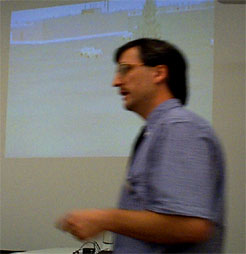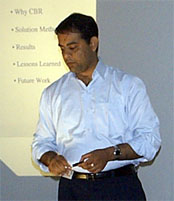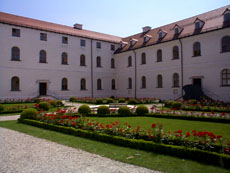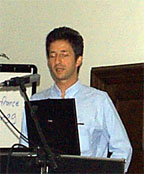ICCBR'99 Day Four
| I was rather surprised to make it to the 9.45am session this morning (considering how late the bar closed the night before). Did you know that about 300 people just vanish in Canada every year? As was explained to us these are mostly incidents involving light aeroplanes and others in the wilderness (not people in downtown Montreal). Irene Abi-Zeid asked Is CBR Applicable to the Co-ordination of Search and Rescue Operations? A Feasibility Study (Abi-Zeid & Yang & Lamontagne). It seemed that the answer is "yes". The problem of co-ordinating a search and rescue operation is fairly case-based at the operational level, involving situation assessment and knowing which information to acquire. The problem is compounded because the controllers are in the military and are only posted to this task for a relatively short time - consequently knowledge management is an important issue. |
|
| The planning session then continued with a fascinating presentation from Erica Melis. Flexibly Interleaving Processes (Melis & Ullrich) described a theorem proving problem in which obtaining proofs from first principles is possible but too inefficient. Case-based planning is also possible but also inefficient. Thus, the system described uses a multi-strategy planner that can run alternate strategies concurrently. A meta-controller uses CBR to decide on which strategy it most likely to succeed. This talk combined with the previous one showed some common approaches demonstrating that case-based planning is a mature subject area. |  |
 |
It was never very likely that David Aha would let the
session end on a dull uninteresting note. Although Hector was first author on Using
Guidelines to Constrain Interactive Case-Based HTN Planning (Muņoz-Avila &
McFarlane & Aha & Breslow & Ballas & Nau) David clearly wanted to show
that the military has better toys than the rest of us. The system presented is a
conversational case-based planner that operates in the domain of non-combatant evacuation
operations (NEOs in military jargon). This is complex planning environment with lots of
uncertainty and dynamism. Again, as with the first presentation, knowledge management is
an important issue because the military are on short tours of duty. After a quick
tour around the planner and how it was built the talk ended with a video showing a
simulation of the CBR planner vs. a heuristic planner. Download the paper (postscript) and the presentation (powerpoint) or view David's website on NEO related information. |
| I wasn't was really quite sure what A Case-Based Methodology for Planning Individualized Case Oriented Tutoring (Seitz) was doing in a session called "diagnosis", but it was a very interesting case-based tutoring paper. Alex Seitz presented a case-based methodology for planning a tutoring process based on the skills of individual users. Past tutoring plans could be retrieved and adapted to encourage students to associate concepts in threads during problem solving. The domain was medical diagnosis (ah..that explains why this was in the diagnosis session). |
|
| Anil Varma of General Electric then presented a
really great application called ICARUS: Design and Deployment of a Case-Based
Reasoning System for Locomotive Diagnostics (Varma). It was really fascinating to
hear that GE uses CBR for several applications (Bill Cheetham presented a poster
describing another application for fault diagnosis of medical scanning equipment
yesterday). As is so often the case large companies use CBR but don't tell the world about
their successes. This application is a real killer and involved analysing fault logs from
locomotives to predict and prempt serious faults. They had tried a rule-based system but
it was too hard to maintain and took 3-4 person years to get to a stage where they
realised it wouldn't work. The CBR system (as is so often the case) used a simple
approach, cost $250,000, took 14 person months to build and solves 75% of the known faults
across 600 locomotives. Estimated saving are in the order of $5 million per year. This was
a very well structured presentation of a very impressive system solving a complex problem.
Oh yes, and what CBR tool did they use? Well, one they built themselves! Download the paper (62.5KB pdf) and the presentation (76.5KB pdf) |
 |
| The final presentation of ICCBR'99 was by Eric Auriol
of Acknosoft described Integrating CBR and Hypermedia Documentation: Application to
the Diagnosis of a Welding Robot at Odense Steel Shipyard (Auriol & Crowder &
MacKendrick & Rowe & Knudsen). This application shared some aspects in common with
Acknosoft's usual complex diagnostic systems with the addition of an interesting
multimedia information repository to assist users in solving problems. ICCBR'99 ended where it began with real commercial CBR applications making money for companies. |
|
 |
So that was ICCBR'99. As usual the best
conference for CBRers. I identified the following trends and themes:
A final thanks to Karl, Ralph and Klaus (and all the volunteers from Kaiserslautern) for organising such a successful conference. |
 |
Don't forget that to get the full value from the
ICCBR conference you'll need a copy of the proceedings which you can order online from
amazon.com Case-Based Reasoning Research and Development : Third International Conference on Case-Based Reasoning, ICCBR-99, Seeon Monastery, Germany, July 27-30 by Klaus-Dieter Althoff, Ralph Bergmann & L. Karl Branting (Eds.). Lecture Notes in AI 1650, Springer, Berlin. ISBN 3-540-66237-5 |
| See you all at EWCBR'00 in Trento Italy next September and at ICCBR'01 in Vancouver, Canada. | |


